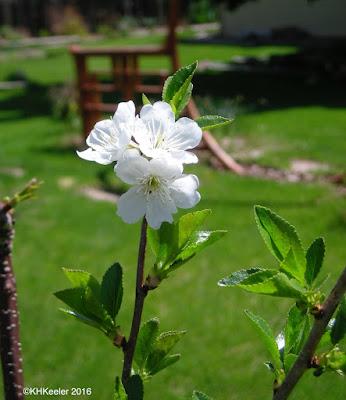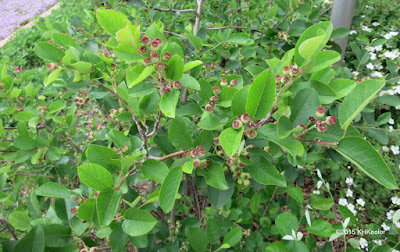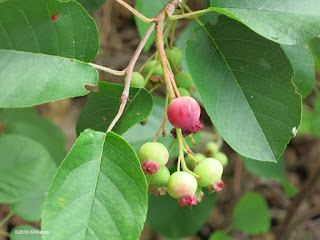A shimmer of white in my front yard: the serviceberry is flowering!
You might call it shadbush like my parents did, or saskatoon, as they do in Canada, or juneberry--the name you might see in the supermarket--or more regionally shadblow, sarvis or sarvisberry, sugarplum, wild-plum or chuckley pear.
All of these are names for native Amelanchier species, mainly A. alnifolia, though there are approximately 10 species native to North America (link: USDA plants)
The serviceberries (that's the basic common name used by the USDA Plants website, the Flora of North America used shadbush) are in the rose family, Rosaceae. The rose family is a big, sneaky group. Apples, plums, cherries, peaches, pears, apricots...they're all in the rose family. A close look at the flowers of all of them and then the fruits and you see the resemblance.
Serviceberries are native all across North America. They are probably the earliest-flowering shrub in most areas.
The official story is that settlers called it serviceberry based on the similarity of the fruit to the plant they knew from Europe, the rowan, called sorbus, service and mountain-ash, genus Sorbus (images). The story I learned was that because it was the first shrub to flower, in the Appalachians it signaled the opening of the roads at the end of winter. The circuit-riding preachers could now reach the outlying villages, to conduct funerals for those who had died during the winter. Serviceberry was the only shrub flowering when the preacher came and, being abundant and white-flowered, it was gathered for the services. I don't know if this story is true, though it is certainly possible.
The name saskatoon is from the Cree name for it, mis�skwat�mina (mis-sask-guah-too-min-a) meaning early berries. We recognize the word because the city of Saskatoon Saskatchewan was named after it.
The city of Saskatoon was founded in 1882 as part of a grant to the Temperance Colonisation Society of Toronto. Their leader, John N. Lake chose the name. Lake wrote
"On the first Sunday in August (1882), I was lying in my tent about 3p.m. when a young man came in with a handful of bright red berries and gave them to me. After eating some, I asked where they were found. He said 'along the river bank.' I asked if people had a name for them. He said they were saskatoon berries. I at once exclaimed 'You have found the name of the town -- SASKATOON.' The name was formally accepted by the directors that winter and entered in the minutes.�
The names shadbush, shadblow and shadberry are eastern North American names. The shad (fish) came up river in large numbers (shad runs) at the same time that local species of serviceberry were blooming. An important fishery in clonial times, the plant cued everyone to expect the fish (the fish, shad fishery history).
Working out the scientific names for particular serviceberries is hard: the plants are quite variable. The leaf shape, for example, can be different on the same plant. Take a moment to look at one near you: leaves on the flower stem can differ from those on non-flowering branches. In fact the same plant may have different shaped leaves depending on how rapidly it grew. Furthermore the different North American species hybridize when they encounter each other. The USDA plants website names three hybrids. They don't do that unless hybrids are quite common. The result is that it can be tricky to key a serviceberry to species.
In my part of the range, there are at most three species. The latest Flora of Colorado called them all Amelanchier alnifolia. Ackerfield treated two former species, A. utahensis and A. pumila, as varieties (subspecies) within the western serviceberry A. alnifolia. Ackerfield commented "A. alnifolia and A. utahensis overlap in morphology and distribution. Many specimens are difficult, if not impossible, to assign to one species or the other." (p. 721)
I have a geneticist's attitude toward subspecies: they represent local races within a species, units that can disappear as easily as they form. I am still working to recognize many plant species, genera and indeed families, I don't have time for subspecies. Experts on a particular plant species find them useful, and they probably reveal interesting patterns in plant history and local adaptation. I however, will now simply try to recognize a serviceberry in Colorado, in which case it is Amelanchier alnifolia. So much simpler!
But what of all those common names? After researching serviceberries, I concluded we should call them saskatoons...a Native American name, not a name based on resemblance to a European tree or to the appearance of a food fish. I was therefore very amused to discover that there's a small industry producing saskatoons commercially. (link scroll down for recipes, another link). As the John Lake quote above indicates, they can be very tasty. The entrepreneurs developing saskatoons for commercial production looked over those name choices and chose...juneberry! They thought saskatoon too difficult for shoppers (!). The fruits are ripe in June and that is one of the strengths of saskatoons.
Plants take time to grow flowers and for the fertilized flowers to develop into ripe fruit. Tasty edible fruits are the packages encouraging animals to eat the fruit and either throw away the seed (peaches and apricots) or pass the seeds through the animal to be deposited somewhere in feces (small wild cherries, roses).
In temperate regions, where the plants are dormant all winter, fresh fruits aren't available in March or April or May...in fact until June. Saskatoon are about the first fruits of the year across most of North America. Consequently they are important foods for wildlife, providing about the earliest berries (as in the name mis�skwat�mina, above).
Fruits of some plants taste better than others, as is normal with wild plants. If you see them in the grocery store (juneberries), try them. Or, plant them.
Not only am I growing an attractive early-flowering native shrub, in June I get a patch of robins.
Comments and corrections welcome.
References
Ackerfield, J. 2015. Flora of Colorado. BRIT Press, Fort Worth, Texas.
Natural Resources Canada. The origins of geographical place names of some Canadian cities. http://www.nrcan.gc.ca/earth-sciences/geography/place-names/origins-geographical-names/9220 Accessed 3/2/15
Saskatoons http://www.prairieberries.com/berry.php
Saskatchewan Place Names http://www.aitc.sk.ca/saskschools/sask/sknames.html
More at awanderingbotanist.com
You might call it shadbush like my parents did, or saskatoon, as they do in Canada, or juneberry--the name you might see in the supermarket--or more regionally shadblow, sarvis or sarvisberry, sugarplum, wild-plum or chuckley pear.
All of these are names for native Amelanchier species, mainly A. alnifolia, though there are approximately 10 species native to North America (link: USDA plants)
The serviceberries (that's the basic common name used by the USDA Plants website, the Flora of North America used shadbush) are in the rose family, Rosaceae. The rose family is a big, sneaky group. Apples, plums, cherries, peaches, pears, apricots...they're all in the rose family. A close look at the flowers of all of them and then the fruits and you see the resemblance.
 |
| Wild rose flowers (Rosa species) |
 |
| Apple flowers, Malus domestica, rose family |
 |
| serviceberry Amelanchier alnifolia flowers |
The official story is that settlers called it serviceberry based on the similarity of the fruit to the plant they knew from Europe, the rowan, called sorbus, service and mountain-ash, genus Sorbus (images). The story I learned was that because it was the first shrub to flower, in the Appalachians it signaled the opening of the roads at the end of winter. The circuit-riding preachers could now reach the outlying villages, to conduct funerals for those who had died during the winter. Serviceberry was the only shrub flowering when the preacher came and, being abundant and white-flowered, it was gathered for the services. I don't know if this story is true, though it is certainly possible.
 |
| flowering serviceberry |
The city of Saskatoon was founded in 1882 as part of a grant to the Temperance Colonisation Society of Toronto. Their leader, John N. Lake chose the name. Lake wrote
"On the first Sunday in August (1882), I was lying in my tent about 3p.m. when a young man came in with a handful of bright red berries and gave them to me. After eating some, I asked where they were found. He said 'along the river bank.' I asked if people had a name for them. He said they were saskatoon berries. I at once exclaimed 'You have found the name of the town -- SASKATOON.' The name was formally accepted by the directors that winter and entered in the minutes.�
 |
| the shad will be running |
In my part of the range, there are at most three species. The latest Flora of Colorado called them all Amelanchier alnifolia. Ackerfield treated two former species, A. utahensis and A. pumila, as varieties (subspecies) within the western serviceberry A. alnifolia. Ackerfield commented "A. alnifolia and A. utahensis overlap in morphology and distribution. Many specimens are difficult, if not impossible, to assign to one species or the other." (p. 721)
I have a geneticist's attitude toward subspecies: they represent local races within a species, units that can disappear as easily as they form. I am still working to recognize many plant species, genera and indeed families, I don't have time for subspecies. Experts on a particular plant species find them useful, and they probably reveal interesting patterns in plant history and local adaptation. I however, will now simply try to recognize a serviceberry in Colorado, in which case it is Amelanchier alnifolia. So much simpler!
But what of all those common names? After researching serviceberries, I concluded we should call them saskatoons...a Native American name, not a name based on resemblance to a European tree or to the appearance of a food fish. I was therefore very amused to discover that there's a small industry producing saskatoons commercially. (link scroll down for recipes, another link). As the John Lake quote above indicates, they can be very tasty. The entrepreneurs developing saskatoons for commercial production looked over those name choices and chose...juneberry! They thought saskatoon too difficult for shoppers (!). The fruits are ripe in June and that is one of the strengths of saskatoons.
 |
| saskatoon fruits, ripening |
In temperate regions, where the plants are dormant all winter, fresh fruits aren't available in March or April or May...in fact until June. Saskatoon are about the first fruits of the year across most of North America. Consequently they are important foods for wildlife, providing about the earliest berries (as in the name mis�skwat�mina, above).
 |
| saskatoons |
However, you may not get any fruit to try. Robins love them. For a week, until the fruits were gone, I'd walk into my yard and the bushes would flutter as the robins ducked away. It was lovely. I am a poor wildlife photographer and the robins were wary, but watch:
Not only am I growing an attractive early-flowering native shrub, in June I get a patch of robins.
Comments and corrections welcome.
References
Ackerfield, J. 2015. Flora of Colorado. BRIT Press, Fort Worth, Texas.
Natural Resources Canada. The origins of geographical place names of some Canadian cities. http://www.nrcan.gc.ca/earth-sciences/geography/place-names/origins-geographical-names/9220 Accessed 3/2/15
Saskatoons http://www.prairieberries.com/berry.php
Saskatchewan Place Names http://www.aitc.sk.ca/saskschools/sask/sknames.html
Kathy Keeler

No comments:
Post a Comment